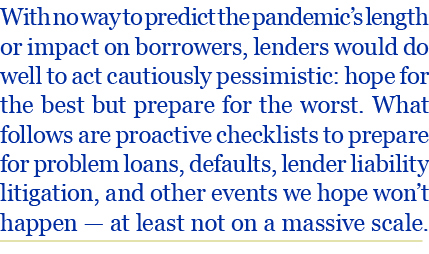By Scott C. Sandberg, Partner, Spencer Fane LLP
The COVID-19 pandemic’s first six months have proven predictably unpredictable for banks. PPP and other government assistance programs might have temporarily staved off widespread loan defaults, but they foisted unique challenges on the banks charged with disseminating relief funds.
And new PPP-related legal challenges for banks have begun rearing their heads. Bankruptcies have spiked, but foreclosures have remained stable relative to previous crisis periods. Financial markets have enjoyed record growth, while unemployment has skyrocketed.
With no way to predict the pandemic’s length or impact on borrowers, lenders would do well to act cautiously pessimistic: hope for the best but prepare for the worst. What follows are proactive checklists to prepare for problem loans, defaults, lender liability litigation, and other events we hope won’t happen — at least not on a massive scale.

Identifying Problem Loans
Consider whether action needs to be taken on loans with one or more of the following issues:
- Uncured monetary or nonmonetary defaults
- Uncooperative or hostile borrowers
- Borrowers involved in lawsuits or with other legal problems
- Borrowers in volatile business sectors
- Diminished collateral value
- Competing claims to collateral
Prepare a problem loan “plan” that includes:
- Measures the bank will take to resolve the problems
- The bank representatives who will communicate with the borrower, and the means of communication
Workout Arrangements
- Document all workout arrangements with signed written agreements
- Determine the preferred workout agreement structure (e.g., forbearance agreement, deed in lieu, modified loan agreements, restructured collateral)
- Obtain a release from the borrower of claims against the bank in exchange for the workout arrangement
- Obtain the borrower’s re-affirmance of the debt and amounts owing
- Resolve existing loan documentation issues (e.g., collateral description or perfection issues, missing signatures)
Loan Enforcement/Litigation
- Involve legal counsel
- Implement a “litigation hold” to prevent the alteration or destruction of relevant documents, paying close attention to electronically stored documents
- Organize and review the loan file and all records relating to the loan
- Compile and review emails and text messages to and from the borrower and internal emails concerning the loan
- Identify and interview all bank representatives with knowledge of the loan or dealings with the borrower
- Instruct all employees not to discuss the loan outside the presence of counsel
- If the bank has charged off the loan, then payoffs should be separately tracked in the same manner as before the charge off
- Determine where litigation will be filed based on dispute resolution provisions in loan agreements and legal requirements
- In the event of claims asserted against the bank, determine whether the bank has insurance covering defense or indemnity for the claim
- Identify any COVID-19 restrictions on loan enforcement (e.g., foreclosure timing or notice requirements or moratoriums)

Scott Sandberg is a partner at Spencer Fane LLP in the firm’s Denver office. He is a commercial litigator who represents clients in trials, arbitrations, appeals and emergency injunction proceedings. For financial services clients, Scott represents lenders and servicers in a broad array of matters, including ag finance, loan recovery, lien priority and lender liability.
This story appears in Issue 2 2020-2021 of the Colorado Banker Magazine.







